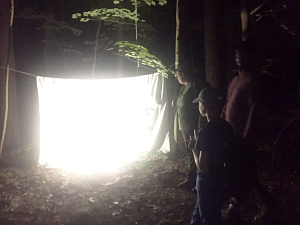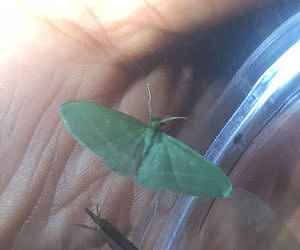
We’re going on a bug hunt and we’re going to catch some big ones! (And then release them back where we found them in their natural environment).
The first thing we learned from our expert guides was how very many different species of bugs there are. Apparently they rule the earth, with the estimated highest number of species out of any phylum. Talk about #BackyardBiodiversity! We couldn’t learn about all of these different species at once, but since our guides were passionate experts on butterflies and moths, those are what we focused on during our walk.

Moths have fuzzy antennae and rest their wings atop their backs, while butterflies have club-shaped antennae and fold their wings together.
After a few minutes of walking in total darkness, we reached the first stop. The guides had set up a white sheet with a black light shining on it, so that we would be able to capture and study the insects that were attracted to the sheet..

These sheets made for an eerily beautiful sight in the darkness of the forest. They were set up in a few locations along the path so we could get a closer look at the moths and butterflies in different habitats.
Among other creatures, we found an emerald moth, a modest sphinx and a tent caterpillar moth. The emerald moth is small and dainty, and is a bright green color as the name suggests.

An emerald moth displays its beautiful color within our collection jar.
The modest sphinx is surprisingly large, and at first our group actually mistook it for a small bat!

A stock image of the modest sphinx shows the 9-14cm wingspan of this gigantic insect.
The tent caterpillar moth was by far my favorite. It’s so cute and fuzzy. However, every ten years or so, the caterpillars breed excessively and defoliate trees, a cycle which has existed since the caterpillar’s introduction to Ontario in the year 1649. But good news-- the trees usually recover from the excessive munching, so the caterpillars rarely cause any permanent damage.

The tent caterpillar moth favors oak and sugar maple trees for food and shelter.
I learned so much from the Bugs of the Night walk, and was so happy to get to experience this forest at a time when I would never go on my own. Some children in attendance stayed up late just for this walk, and witnessing their unbridled enthusiasm for hands-on learning in nature was inspiring, and it reminded me to always stay curious and excited about nature! Visit our website to learn more about Backyard Biodiversity, and how you can attract awesome creatures like these to your yard by planting shrubs, trees, or garden kits!
Rachel is the Marketing and Education Assistant at LEAF.
York Region supports our Backyard Tree Planting Program. For details on how you can participate, visit www.yourleaf.org
